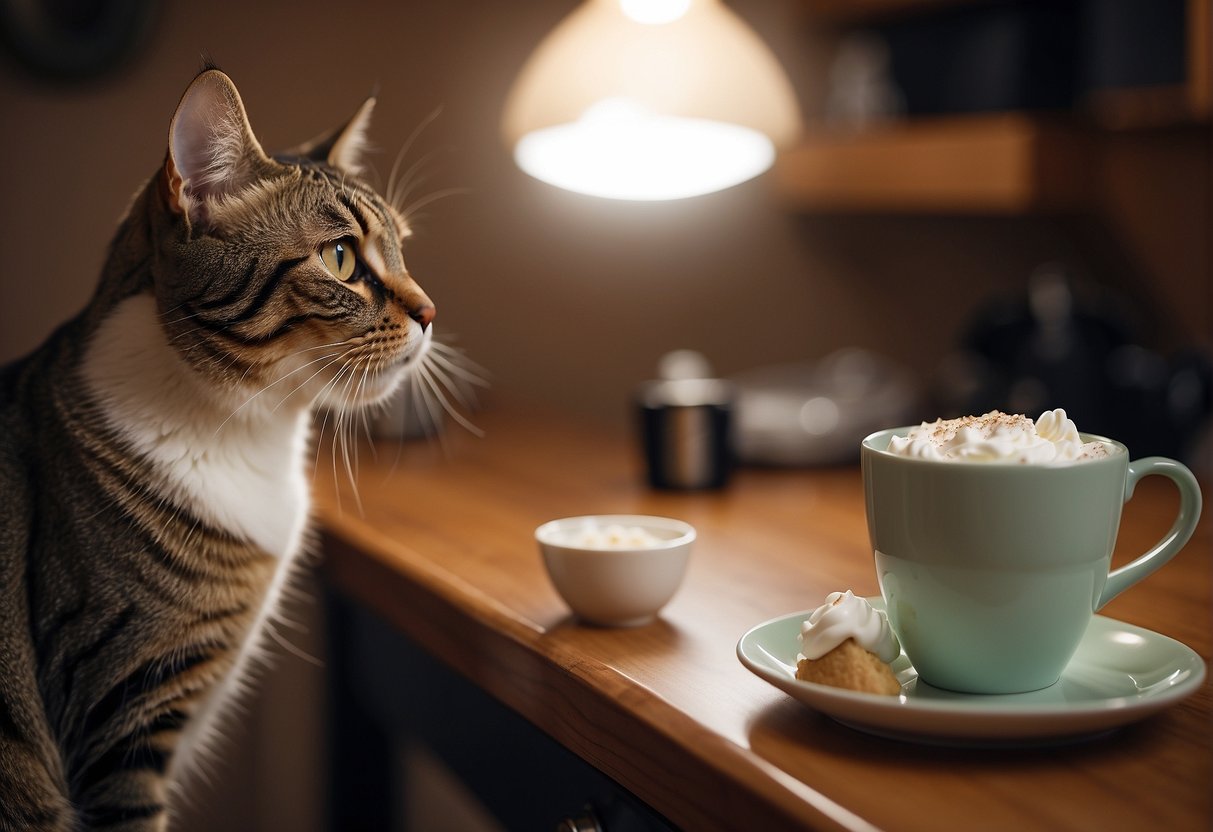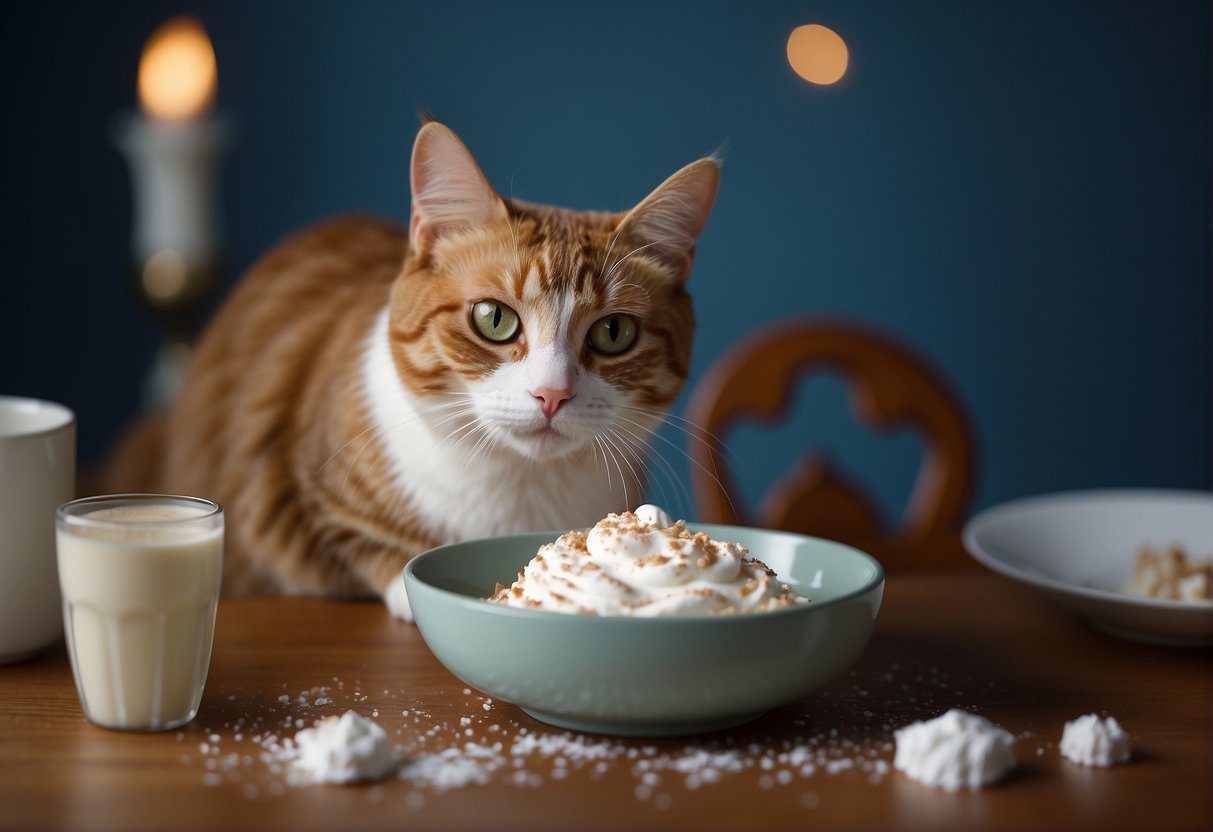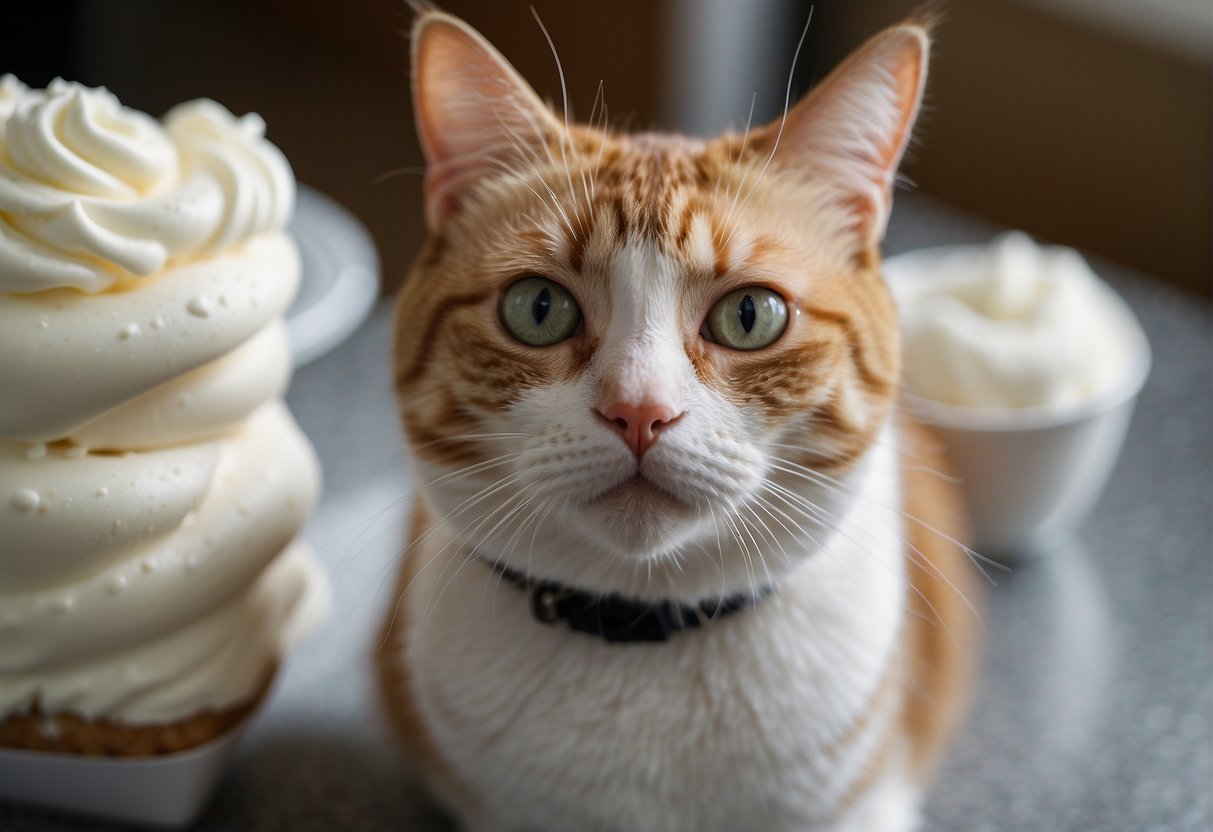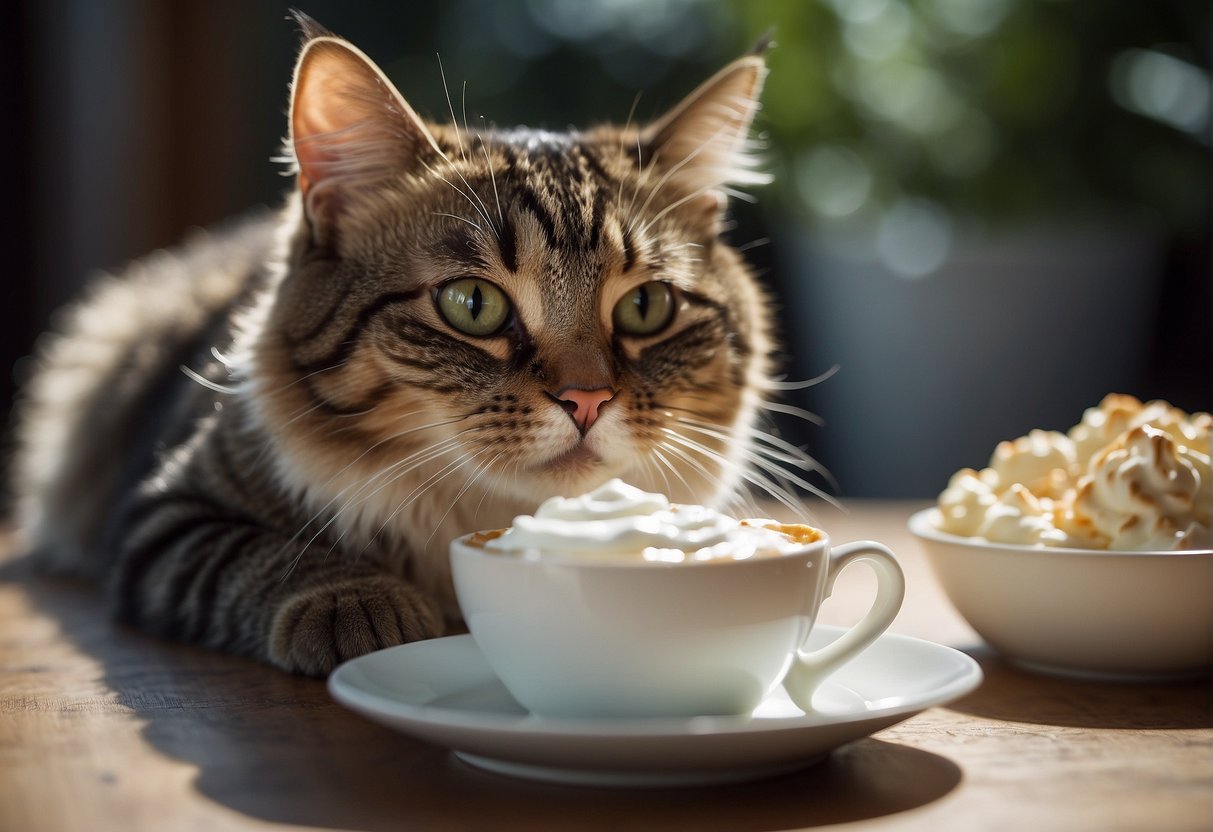Like a scene from classic cartoons where the family pet gets a lick of a sweet treat, you’ve probably wondered if offering whipped cream to your kitty is a harmless indulgence.
Cats often show an interest in what we eat, and their little licks and curious sniffs at our dessert plates might prompt the question: Can cats have whipped cream?
While small quantities of whipped cream may not be harmful, it is not a natural component of a cat’s diet, which should primarily consist of protein-rich foods.

Understanding whether this creamy treat, whipped cream, is safe for our feline friends is crucial.
This guide is here to navigate through the fluff and give you the scoop on whipped cream’s safety for cats, explore the potential health implications, and ensure you’re making the best choices for your whiskered companion.
Key Takeaways
- Whipped cream is non-toxic but may lead to gastrointestinal distress in cats.
- Most cats are lactose intolerant, making dairy-based treats a risky choice.
- There are safer treat alternatives specifically formulated for cats.
Understanding the Safety of Whipped Cream for Cats
Typically, it’s just heavy cream and a spoonful of sugar, including corn syrup. Sounds simple, but this combo packs a high-fat, high-calorie punch.
Why should you care?
Knowing what’s in your whipped cream, including corn syrup, helps you make informed snack-time decisions for your furball, especially when considering their nutrition and maintaining a healthy cat.
Non-Toxic Nature As a cat parent, it’s a relief to know that whipped cream doesn’t contain anything immediately harmful.
No toxins here! But, the question is, just because it’s non-toxic, does that mean it’s a ‘purrfect’ treat for your feline friend?
Lactose Intolerance in Cats Now, here’s a fun fact – around 65-75% of adult cats can’t properly digest lactose, resulting in digestive issues such as bloating, awful flatulence, stomach pain and cramping, vomiting, and diarrhea.
That’s a lot of potentially upset tummies! Dairy and cats can be a mix as complicated as trying to take a cat for a walk on a leash.
Lactose intolerance can turn that innocent creamy treat into a digestive debacle. So, before sharing, consider if your whiskered companion is part of the lactose-intolerant majority.
When you put it all together, while the whipped cream toppings might be safe on the surface, it’s worth thinking twice.
Your kitty’s health is the priority, and those adorable eyes shouldn’t sway you into sharing coconuts, almonds, or soy that may lead to a bellyache.
Short on treats? Better to stick to the cat-friendly options out there, including avoiding generic store brands. Your cat might thank you with some extra purrs and cuddles!
The Potential Risks and Considerations

Ever caught your fluffy friend eyeballing your whipped cream-topped dessert? You might wonder, can Mr. Whiskers share your sweet treat?
While that dollop of creaminess appeals to your tastebuds, let’s dish out why it’s not the best idea for your kitty.
Lactose Intolerance Effects
Cats often become lactose intolerant as they grow. Like some humans, they can’t properly digest lactose, which is found in dairy products. (1)
Here’s what could happen:
- Gas
- Bloating
- Diarrhea (2)
- Abdominal pain
Remember the case of Bailey? The tabby that had a lick and ended up with a grumbly tummy for days? A clear sign that whipped cream isn’t cat-friendly.
Digestive Issues
And then there’s the high-fat situation. Too much fat equals one upset kitty belly.
- A little whipped cream? Possibly okay.
- A lot of whipped cream? Hello, gastrointestinal upset! (3)
Obesity and Weight Gain
About 60% of cats in the U.S. are classified as overweight or obese. Let’s not make matters worse with unnecessary calories from whipped cream.
Apart from whipped cream which can cause obesity, rice, which we think is not dangerous for our cats, can also cause obesity if we consume too much of it.
Imagine Oliver, the ginger cat who couldn’t resist and ended up too hefty to leap onto his favorite perch.
That’s a no-go.
To keep your feline’s figure svelte and health in check, it’s essential to bypass these high-fat treats.
Your beloved ball of fur will thank you with purrs and playful times—minus the unnecessary discomfort or extra pounds!
Keep these pointers in mind, and both you and your pawed pal can enjoy snack time worry-free.
Safe Ways to Offer Whipped Cream to Cats

Cats may be curious about whipped cream, but moderation is key.
Think about treating your feline friend to just a small spoonful of sugary goo, which are healthy snacks in moderation, on rare occasions – like a tiny dollop of healthy snacks on your fingertip.
That’s the sweet spot, literally!
Whipped Cream Portion Size:
- Ideal Treat Size: Just the tip of a teaspoon
If you’re feeling adventurous and want to try something different, how about some cat-friendly alternatives?
There are treats that can mimic whipped cream without the dairy downside.
Here are a couple of alternatives:
- Plain, Unsweetened Yogurt:
It’s gentler on their tummy and still gives that creamy satisfaction. - Specialized Cat Treats:
They come in various flavors and textures, which can add some excitement to your cat’s treat time.
Want to hear a purr-fect idea? Grab a can of commercially available cat-safe whipped cream.
Yes, they make those! These are often lactose-free, tailored for your cat’s dietary needs.
**A Whipped Cream Alternática for Cats:
- Cat-Safe Brand to Look For: Kitty Whip (lactose-free)
Giving Kitty Whip a try would surely make your kitty’s day. It’s designed with your furry friend’s health in mind, ensuring happy tummies all around.
Remember, though, even these specialized creams should be offered sparingly. Think of it as an exclusive club your cat gets to join occasionally.
Isn’t that something special? Keep those whiskers twitching in delight without overdoing it.
A happy cat means a happy you!
Signs of Whipped Cream Allergies or Sensitivities

Ever shared a dollop of whipped cream with your kitty and noticed some funky after-effects?
Cats can be quite sensitive to dairy, and whipped cream is no exception. Keep an eye out for lactose intolerance or allergic reactions. (4)
Here’s what might tickle—well, more like trouble—your feline friend:
Symptoms to Watch For:
- Diarrhea:
Surely you know your cat’s bathroom habits like the back of your hand, so this one’s hard to miss. - Gas:
If Fluffy’s clearing the room, it may be more than just the regular funk. - Vomiting:
No, they probably didn’t just eat too fast. - Abdominal Pain:
Is your cat more grumpy or reticent to play? They might not be just lazy.
Remember Mr. Whiskers from next door? One tiny taste of whipped cream, and his belly went haywire. It was a messy tale of late-night cleanups for days!
Immediate Veterinary Attention:
If your kitty’s showing any severe signs—or you’ve got a repeat of the Mr. Whiskers fiasco—don’t play Dr. Dolittle. It’s time to ring up your vet, pronto.
Take the case of Luna, who once snuck a good lick of whipped cream. The ensuing tummy turmoil had her humans worried sick!
Thankfully, they didn’t wait to seek professional help.
TL;DR: If little Snowball seems queasy after indulging in some creamy treat, better be safe and get that checked out.
Let’s keep those nine lives long and prosperous, shall we?
Information About Lactose Intolerance
Have you heard your kitty friends gossiping about lactose intolerance? Well, it turns out it’s a real buzzkill for many cats.
Lactose intolerance in cats means they lack enough lactase, the enzyme required to digest lactose—a natural sugar found in milk, ice cream, yogurt, and yes, even whipped cream.
Now, you may think all cats adore milk, right? But in reality, they might not always be able to stomach solid food.
Here’s a surprising cat fact for you: quite a few cats are lactose intolerant, and this sensitivity can increase as they move away from kittenhood.
So, if you’ve ever noticed your cat getting a little, let’s say, musical after dairy, now you know why.
Why Whipped Cream May Not Be Suitable
You might be thinking, “But my cat looks so cute licking up whipped cream!”
And they sure do, but here’s the scoop—whipped cream is dairy-based, which means it contains lactose. This could lead to a catty version of a tummy trouble episode.
Picture this: Whiskers, the neighborhood cat, sneaks a lick of whipped cream and soon after, he’s feeling bloated and uncomfortable. Poor Whiskers, right?
That’s a classic case of lactose intolerance kicking in action.
Making Informed Choices
Before you treat your furball to a dollop of whipped cream, it’s best to consider their digestive system.
Every cat is an individual, and what’s a treat for one could be trouble for another.
Curious how to pick the right treats? Follow this simple guide:
- Observe Your Cat: Do they have a sensitive stomach?
- Go Slow: Introduce new foods a tiny bit at a time.
- Watch for Signs: Any change in behavior or digestion? Time to reevaluate.
It’s not just about what’s a treat—it’s about what’s a treat that suits your cat.
Keep it safe, keep it digestible, and keep those purrs coming. Happy treating!
Quick Recap

Have you wondered whether a dollop of whipped cream is a treat or a no-go for your cat? Let’s break it down in simple bites!
What’s the Scoop on Whipped Cream?
- Base Ingredients:
Essentially, whipped cream is heavy cream whipped to a froth with some sugar and maybe vanilla. - Cats and Dairy:
Despite popular beliefs, many cats are lactose intolerant, meaning dairy can upset their stomachs.
Risks to Consider
- Intolerance Indicators:
Lactose intolerance can lead to nausea, diarrhea, and vomiting. Not fun for your kitty or your carpet! - Nutritionally Void:
Whipped cream lacks the essential nutrients cats need. - Weighty Issues:
Too much whipped cream can contribute to your cat’s waistline, leading to obesity.
Moderation and Alternatives
Remember, while a tiny lick might pass under the radar, it’s best to provide treats designed for cats. They’re carnivores at heart, so stick to meat-based rewards.
Responsible Nibbles
- You love your furry friend, right? Prioritize their diet just as you would your own wellness.
- Nourishing Bites: Choose treats packed with animal proteins and fibers.
If you’re still tempted to share your dessert, just think: is a moment of creamy indulgence worth a potential tummy ache for your feline pal?
Considering the lactose intolerance common in many cats, opting for non-dairy cat treats can provide a safe and enjoyable alternative, ensuring your feline friends can still enjoy a tasty snack without the digestive discomfort associated with whipped cream.
Stick to feline-friendly snacks, and you’ll both be happier for it!
Frequently Asked Questions
Navigating the world of feline-friendly foods can be tricky.
Let’s clear the air about whether your purring pal can indulge in whipped cream with some of your most asked questions.
Can cats have whipped cream?
You might find your cat begging for a taste while you’re enjoying some whipped cream.
In small amounts, it’s not toxic, but it’s not a natural part of a cat’s diet, which should be rich in proteins.
Is whipped cream safe for all cats?
Not exactly. While a tiny dollop won’t send them to the vet, many adult cats are lactose intolerant, meaning dairy products could upset their stomach.
What are the potential risks of giving whipped cream to cats?
Whipped cream contains dairy, which is hard for many cats to digest.
Too much could lead to stomach upset, diarrhea, and obesity due to high fat and sugar content. It’s a treat best given sparingly.
How can I tell if my cat is lactose intolerant?
After consuming dairy, if your cat experiences symptoms like diarrhea, vomiting, or stomach discomfort, they might be lactose intolerant.
It’s fairly common among adult cats.
How much whipped cream is safe for cats to consume?
Think in terms of a small taste—perhaps a pea-sized amount on occasion. Moderation is key.
Even if your cat is not lactose intolerant, whipped cream shouldn’t become a regular treat due to its high-calorie content.
Are there any alternatives to whipped cream for cats as treats?
Absolutely! Consider cat-safe treats like small pieces of cooked chicken or fish that are healthier and cater to their carnivorous needs.
Alternatively, special cat treats designed for digestibility are a better choice.
Can kittens have whipped cream?
Kittens are more likely to tolerate lactose than adult cats.
However, their developing digestive systems are best supported with kitten-formulated milk or their usual milk replacer, not human foods like whipped cream.
- Where to find the most trustworthy real money casinos - August 7, 2025
- Online Casinos That Approve PayPal: The Ultimate Overview - August 7, 2025

